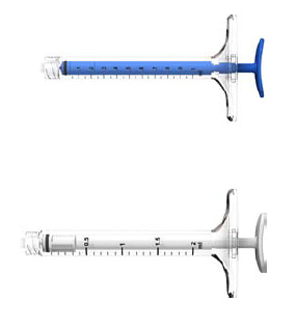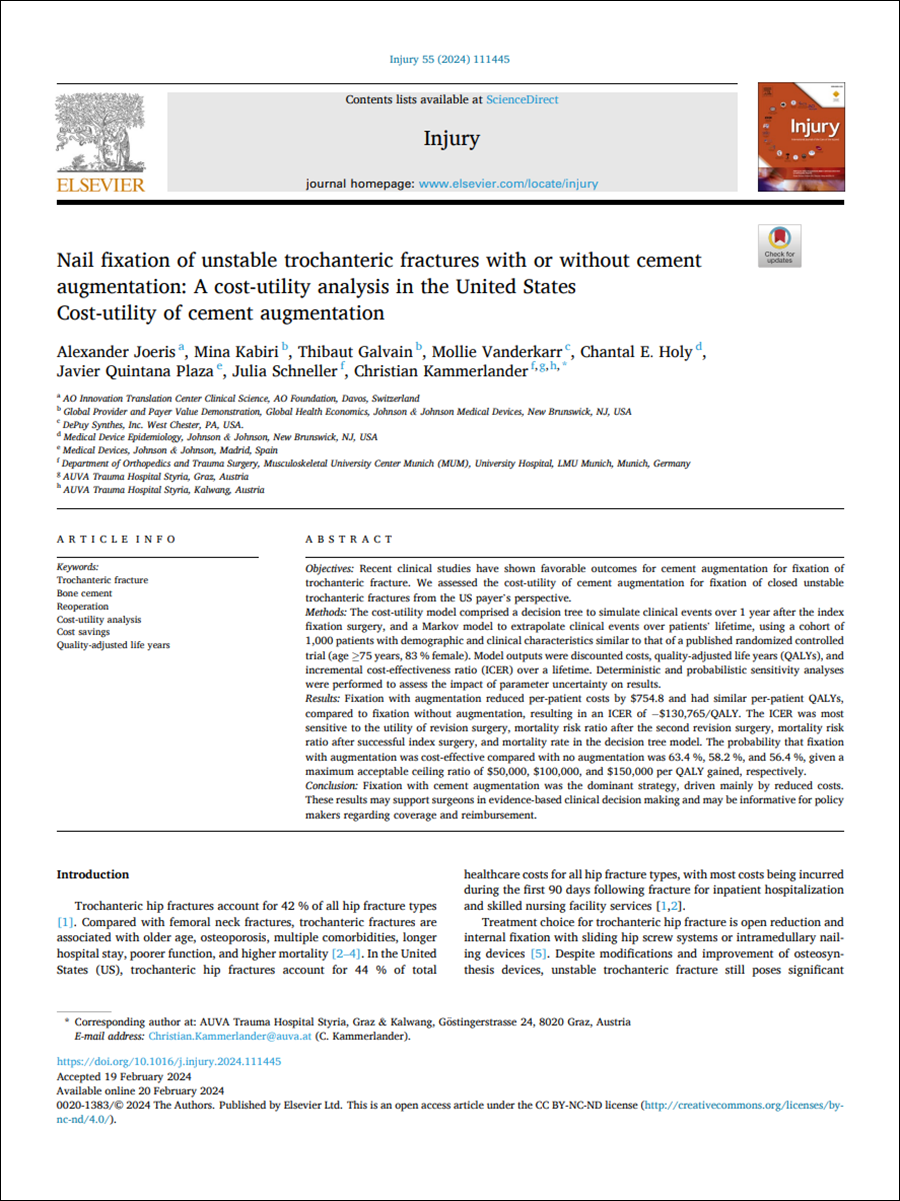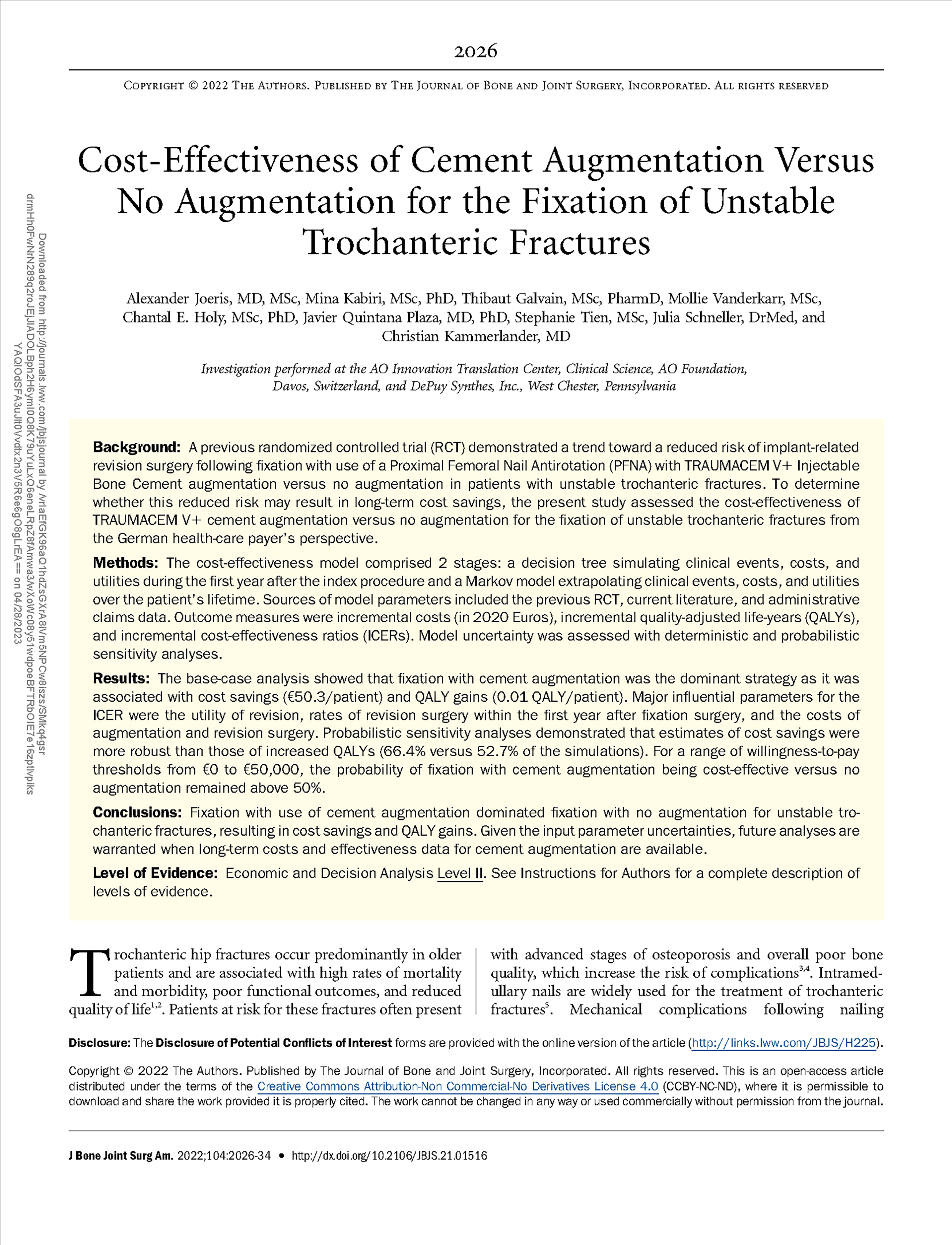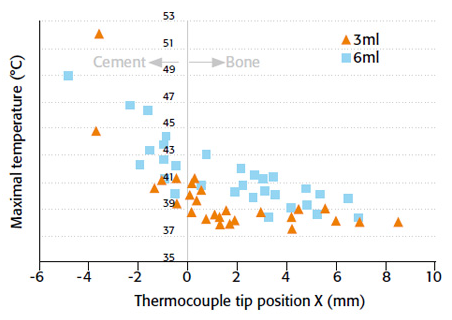
PFNA Augmentation
Christian Kammerlander, Michael Blauth
The Proximal Femoral Nail Antirotation (PFNA) in its short and long versions is indicated for pertrochanteric fractures, intertrochanteric fractures, and high subtrochanteric fractures. In addition, the long version is indicated for low and extended subtrochanteric fractures, ipsilateral trochanteric fractures, segmental fractures of the femur, and pathological fractures. As an added benefit a cement augmentation is available. Indications are unstable pertrochanteric fractures in severe osteoporotic patients.
Perforated blade
The new perforated blade (Fig 1) comes in lengths of 75-130 mm in 5 mm increments and is available in titanium and stainless steel. The insertion/extraction instrument can be used with the new blade because the interface is exactly the same. The existing PFNA implants and instruments are fully compatible with the new perforated blade.
Traumacem V+ cement kit (Fig 2)
The Traumacem V+ is a polymethylmethacrylate (PMMA) cement which is highly viscous immediately after preparation. The special mixing device comprises the powder which is mixed with the monomer from the glass ampoule (Fig 3). After mixing, the cement is filled into special syringes (Fig 4) using an additional connector (Fig 5). The special side-opening cannula is filled with cement and allows controlled placement of the cement around the blade.
Augmentation
After finishing the usual procedure of inserting the nail and the perforated blade, a leakage into the joint has to be excluded by injection of contrast medium through the perforated blade first. Then the prefilled side opening cannula is inserted into the blade and the position checked by image intensifier. A medial perforation must be avoided. Furthermore, the special 1 ml syringe is adapted to the cannula (Fig 6) and the cement can be injected (Fig 7). By turning the cannula the positioning of the cement around the helical blade can be navigated. Around 36 ml of cement should be injected. The whole injection procedure must be done under image intensifier control.
First clinical experiences
In the authors' department (University Clinic Innsbruck, Austria) 24 cases have been performed where there has been no cement leakage into the hip joint, nor were there any catastrophic failures like cutout or cut-through of the blade. The authors believe that cement augmentation is a powerful and safe tool to prevent catastrophic failures in unstable pertrochanteric fractures. A prospective multicenter trial is under preparation.
Case provided by Christian Kammerlander and Michael Blauth, Innsbruck, Austria
An 82-year-old woman with an unstable pertrochanteric fracture of the right proximal femur. Her Barthel Index was 80 and her preoperative Parker mobility score was 5, which means that she was walking at home unassisted. The patient's preoperative Parker mobility score of 5 was reached again at the 3-month follow-up.
Augmentation of a proximal femoral nail construct
Nail fixation of unstable trochanteric fractures with or without cement augmentation: A cost-utility analysis in the United States Cost-utility of cement augmentation
The objective of this cost-utility analysis was to determine whether fixation with cement augmentation was cost-effective versus fixation without augmentation for closed unstable trochanteric fractures from the US healthcare payer’s perspective.
Joeris A, Kabiri M, Galvain T, et al. Nail fixation of unstable trochanteric fractures with or without cement augmentation: A cost-utility analysis in the United States: Cost-utility of cement augmentation. Injury. 2024 Apr;55(4):111445.
Cost-Effectiveness of Cement Augmentation Versus No Augmentation for the Fixation of Unstable Trochanteric Fractures
Study to determine whether cement augmentation was cost-effective compared with no augmentation for the fixation of closed trochanteric fractures using a PFNA in the German health-care setting.
Joeris A, Kabiri M, Galvain T, Vanderkarr M, Holy CE, Plaza JQ, Tien S, Schneller J, Kammerlander C. Cost-Effectiveness of Cement Augmentation Versus No Augmentation for the Fixation of Unstable Trochanteric Fractures. J Bone Joint Surg Am. 2022 Nov 16;104(22):2026-2034.
Cement augmentation of the Proximal Femoral Nail Antirotation (PFNA) – A multicenter randomized controlled trial
Investigation on the clinical effects of the additional use of bone cement with the PFNA in mobile elderly patients with closed unstable trochanteric fractures on functional outcome as indicated by the postoperative recovery of walking speed.
Kammerlander C, Hem ES, Klopfer T, Gebhard F, Sermon A, Dietrich M, Bach O, Weil Y, Babst R, Blauth M. Cement augmentation of the Proximal Femoral Nail Antirotation (PFNA) - A multicentre randomized controlled trial. Injury. 2018 Aug;49(8):1436-1444.
AO Research Institute Davos biomechanical study
Biomechanical Potential of PMMA-Augmented PFNA Blades to Prevent Implant Cutout
Objective
Helically shaped cephalic implants have proven their benefit to achieve better stabilization for the treatment of unstable intertrochanteric hip fractures. However, cutout ratios up to 3.6% still occur. This in vitro study investigated the cutout resistance of the Proximal Femoral Nail Antirotation (PFNA) blades with polymethylmethacrylate (PMMA) augmentation in surrogate and human specimen femoral heads.
Materials/Method
Twenty-four surrogate femoral heads simulating porotic cancellous bone as well as six pairs of human specimen femoral heads were instrumented with a perforated PFNA blade (Fig 8). Bone mineral density (BMD) of the human specimens was measured by pqCT. For the surrogate femoral heads, four study groups were formed with central and off-center position of the implant in an augmented (3 ml Vertecem V+) and nonaugmented fashion. Within each human specimen bone pair, one blade was augmented using 3 ml of Vertecem V+ bone cement. Starting at 1000 N compression in physiological orientation, the load was monotonically increased by 0.1 N/cycle until failure of the construct. Movement of the head with respect to the blade was identified by means of optical motion tracking and x-rays at 250-cycle increments. Standard test statistics were performed on the cycles until failure to identify differences between study groups.
Results
Surrogate samples: augmented samples clearly showed an increased number of cycles to failure compared to their control (all P = 0.012). In the groups with centric position of the PFNA blade, augmentation led to an increase of failure load by 100%. In the groups with off-center positioning of the blade, failure load was even increased by 150% due to cement augmentation (Fig 9).
Human specimen samples: a significantly larger number of cycles to cutout was found for the augmented group (P = 0.028). A significant correlation was observed between BMD and cycles to cutout for the nonaugmented specimens (P < 0.001, R2 = 0.97, Fig 10), whereas no correlation was found for the augmented group (P = 0.4, R2 = 0.18).
Conclusion
The results of this in vitro study suggest that cement augmentation of the PFNA blade clearly enhances the biomechanical stability under cyclic loading. The procedure is primarily indicated for osteoporotic bone and appears to be a valuable treatment option with clinical benefits in the elderly that seem to outweigh any possible risks associated with implant augmentation [1].
Reference
1) Sermon A, Boner V, Boger A, et al. Potential of polymethylmethacrylate cement-augmented helical proximal femoral nail antirotation blades to improve implant stability - a biomechanical investigation in human cadaveric femoral heads. J Trauma Acute Care Surg. 2012 Feb;72(2):E54-59.
AO Research Institute Davos biomechanical study
Heat Generation during PMMA Augmentation of PFNA Blades [1]
Objective
To reduce the risk for implant cutout in the osteoporotic hip, cement augmentation is a potential method to strengthen the implant purchase. Previously conducted biomechanical studies have clearly demonstrated superior biomechanical behavior of augmented Proximal Femoral Nail Antirotation (PFNA) blades compared to nonaugmented ones. Nevertheless, there is concern about thermal bone necrosis due to the exothermic curing of polymethylmethacrylate (PMMA)-based bone cements. The objective of this in vitro study was to quantify the temperatures arising around perforated titanium PFNA blades during PMMA augmentation.
Materials/Methods
Cylindrical samples from six pairs of fresh frozen human specimen femoral heads were used in this study. The specimens were assigned to two study groups for a randomized left to right comparison: 3 ml versus 6 ml cement. After centric insertion of the PFNA blade, six 1 mm holes were drilled radially around the tip of the implant allowing tight fitting of six K-type thermocouples at varying distances to the center of the blade (Fig 11). To simulate physiological conditions the samples were placed in a 37°C water bath (Fig 12). Bone cement (Vertecem V+)* was injected in a standardized manner and temperatures were continuously recorded until full curing of the cement. Maximal temperatures were identified for all thermocouples.
After testing, the locations of all thermocouples with respect to the cement cloud were reconstructed by means of pqCT. The distance of each thermocouple to the cement-bone interface was calculated. Data was statistically analyzed using parametric tests.
Results
The highest temperature of the experiment was 45.5° ± 2.6°C (mean ± SD) for the 6 ml group and 44.6° ± 5.3°C for the 3 ml group. These values were measured inside the cement cloud. The maximum temperature recorded in the surrounding cancellous bone was 43.1°C for the 6 ml group compared to 41.1°C for the 3 ml group (Fig 13). No temperature in the bone remained for longer than 600 seconds above 40°C. The average maximal temperature was significantly lower for the 3 ml group compared to the 6 ml group (P = 0.01).
Conclusion
Based on the available literature the results of this study suggest that augmentation of titanium PFNA blades to reinforce implant purchase is not associated with a risk of thermal bone necrosis when using up to 6 ml of PMMA bone cement. However, it could be demonstrated that larger amounts of cement lead to higher polymerization temperatures. PMMA application should therefore be kept at a minimum to alter the biological system to the least possible extent.
Reference
1) Fliri L, Lenz M, Boger A, Windolf M. Ex vivo evaluation of the polymerization temperatures during cement augmentation of proximal femoral nail antirotation blades. J Trauma Acute Care Surg. 2012 Apr;72(4):1098-1101.
* Vertecem V+ has the same material and physical properties as Traumacem V+.
Hazards and labeling
Due to varying countries’ legal and regulatory approval requirements, consult the appropriate local product labeling for approved intended use of the products described on this website. All devices on this website are approved by the AO Technical Commission. For logistical reasons, these devices may not be available in all countries worldwide at the date of publication.
Legal restrictions
This work was produced by AO Foundation, Switzerland. All rights reserved by AO Foundation. This publication, including all parts thereof, is legally protected by copyright.
Any use, exploitation or commercialization outside the narrow limits set forth by copyright legislation and the restrictions on use laid out below, without the publisher‘s consent, is illegal and liable to prosecution. This applies in particular to photostat reproduction, copying, scanning or duplication of any kind, translation, preparation of microfilms, electronic data processing, and storage such as making this publication available on Intranet or Internet.
Some of the products, names, instruments, treatments, logos, designs, etc referred to in this publication are also protected by patents, trademarks or by other intellectual property protection laws (eg, “AO” and the AO logo are subject to trademark applications/registrations) even though specific reference to this fact is not always made in the text. Therefore, the appearance of a name, instrument, etc without designation as proprietary is not to be construed as a representation by the publisher that it is in the public domain.
Restrictions on use: The rightful owner of an authorized copy of this work may use it for educational and research purposes only. Single images or illustrations may be copied for research or educational purposes only. The images or illustrations may not be altered in any way and need to carry the following statement of origin “Copyright by AO Foundation, Switzerland”.
Check www.aofoundation.org/disclaimer for more information.
If you have any comments or questions on the articles or the new devices, please do not hesitate to contact us.
“approved by AO Technical Commission” and “approved by AO”
The brands and labels “approved by AO Technical Commission” and “approved by AO”, particularly "AO" and the AO logo, are AO Foundation's intellectual property and subject to trademark applications and registrations, respectively. The use of these brands and labels is regulated by licensing agreements between AO Foundation and the producers of innovation products obliged to use such labels to declare the products as AO Technical Commission or AO Foundation approved solutions. Any unauthorized or inadequate use of these trademarks may be subject to legal action.
AO ITC Innovations Magazine
Find all issues of the AO ITC Innovations Magazine for download here.
Innovation Awards
Recognizing outstanding achievements in development and fostering excellence in surgical innovation.


























